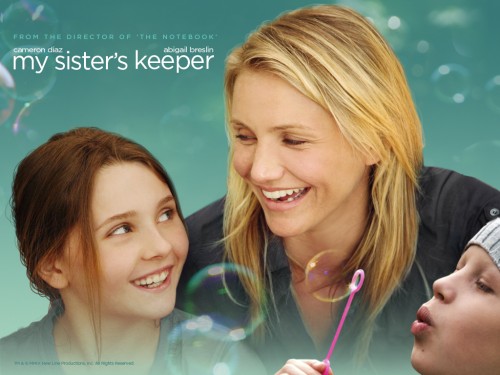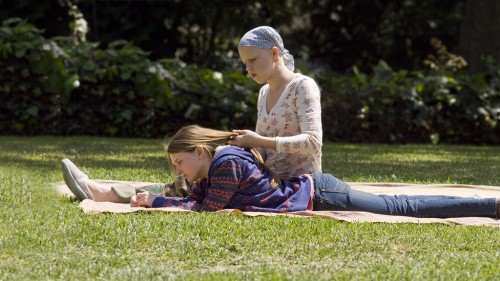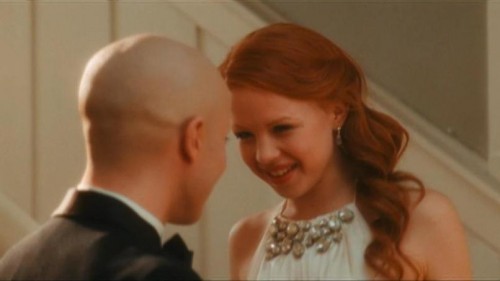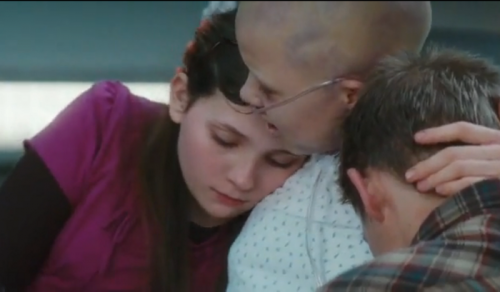
This guest post by Wolf appears as part of our theme week on Child and Teenage Girl Protagonists.
My Sister’s Keeper is a film based off of a book of the same name. Books that become movies follow a set sequence of events: the book fans anticipate the film, new-comers are targeted by the studios, the choice of what to cut/what to keep is made, some movie fans read the book, and the endless debate over which is better ensues. Both versions of My Sister’s Keeper take the wonderful approach of letting the main characters take turns telling the story. Some people, myself included, learn to love both based on their own merit. The book has a goal and story to tell that differs from the movie. The movie has its own unique story and goals. The biggest difference is the main characters; the movie focuses on Kate and the book centers on Anna. The storyline of two sisters whose lives are entwined stays intact in either case.
Anna exists because of Kate, literally. Kate has cancer, leukemia to be specific, and was diagnosed when she was under 5 years old. She is almost certainly terminal. Her parents aren’t a match, much to their shock and dismay. Jesse, her older brother, isn’t a match. They are given the suggestion to create a designer baby, one who will be the perfect genetic match for Kate. This brings us to our second character, Anna (Andromeda in the book, named by her father, Brian, who is a firefighter and amateur astronomer). Kate takes the cord blood first, stem cells, blood, other small donations later, and by the time the story really begins Kate needs Anna’s kidney. Anna files a lawsuit for medical emancipation to prevent the forced donation.
I could honestly write half a book about the portrayal of this fictional family in both the book and film (Kate, the cancer-stricken crux of the family; Sara, the supermom; Brian, the level-headed father; Jesse, the forgotten child; Anna, searching for who she is). The idea that there is a pro-life/pro-choice metaphor (suggested by Roger Ebert in his review) is also interesting and perhaps a good subject for another day.
But the objective here is Anna and Kate, two children who are growing up and having to act more grown-up than they really are.

Kate is a child, but she faces an event typically reserved for adults: death. Kate knows she is dying. She holds no illusions. She has even tried to kill herself. She also suffers for others, but not like Anna does; she lives through the agony of cancer for the sake of her family. She has a mature acceptance of death most of the adults around her do not. At times in the movie, she seems to be the only one living in reality. Her parents fail her in this aspect–they want to save her, even if that means denying the reality of her situation and keeping her in pain. She doesn’t only suffer physically. She has the emotional trauma of knowing her cancer is harming her parents’ marriage, her brother is ignored in lieu of focusing on her (in the book, Sara admits she gave up on him), and Anna’s life revolves around saving Kate.
Both daughters must grow up because their parents fail them. They love them, undoubtedly, but they do not always act in their best interest nor are they often granted agency. Sure, when Kate wants to miss school in the books because of her cancer-stricken appearance Sara allows this. She understands a teenage girls’ vanity. But her desire to end her suffering is ignored. Anna is granted small choices as well based on her desires, but despite her mother’s claims she is being forced to donate her body parts. By the very fact that Sara pushes her to donate and fights the case in court shows she doesn’t care about Anna’s wishes.
Anna’s well-being (the procedures are painful and dangerous) is not taken fully into account. In the books, Brian didn’t want her to donate again when Kate’s cancer reemerged. She didn’t remember the blood draws or injections, but if they had her donate again she would be old enough to remember. He is overruled and concedes to save Kate. The judge doesn’t find her parents guilty of any neglect or indifference but can see that this choice is complicated and Anna needs a voice of her own. (Sara and Brian will speak for Kate’s best medical interest; her wish to die isn’t considered valid.)
Kate wasn’t expected to live past 5. Sara plans as though she will survive in both versions, even telling Dr. Chance that he will come to her wedding one day. Brian stopped dreaming of milestones to avoid the pain when her cancer came back or became more aggressive. In the movie, Kate doesn’t talk about her future; even while “dating” Taylor they talk about their impending deaths. Kate is taken aback in the book when she is asked about her future plans–no one asks her that, even as they fight to keep her alive. She confides that she wants to be a ballerina because they have “absolute control. When it comes to their bodies they know exactly what will happen.” These small situations are more drawn out in the books. Kate hemorrhages from the leukemia; blood is gushing out every opening it can find, from head to toe. Sara gives her a pad and wonders if she will live long enough to get her first period. She will likely not live to experience growing up the way most people do before they die.
For this reason, in both versions, her parents allow her to go to a hospital dance for patients. Taylor, her “boyfriend,” is a rare joy for Kate. In the movie, she finds the perfect wig and dresses like a princess. In the book, she can’t stand wigs and must wear a mask because she is so compromised. Her sexuality is treated differently than it would be if she were cancer free. In the movie, Taylor and she either have sex or “do stuff” that is sexual in nature. But it’s hard to be upset by this. We can’t after all ask her to wait–she’s already living past her life expectancy. Fertility and STDs are not concerns for a girl with cancer. In the book, they only kiss. Sara allows this despite the medical risks, despite the fact that it might kill her–because she knows Kate needs this moment. Every girl needs her first kiss.
This point is driven home when Taylor dies soon after the dance.
It’s only a matter of time before Kate dies as well.

Anna could in theory save Kate. If she were willing, if the hospital signed off, if Kate’s body could handle surgery, and if her kidney functioned well in her sister’s body. Anna files the lawsuit because her sister wants to die and she was asked to “set [her] free.” Anna in all actuality would give her kidney or her right arm or everything she had to save her sister. But the guilt is real. Whether it’s cheerleading and soccer (movie) or hockey and studying abroad (book), Anna really does want her own life and future. She isn’t just expected to save her sister at her own expense but agrees with this prescription for her life. She doesn’t have any real friends nor does Kate. They have each other and that’s enough. But Anna had to give up hockey camp in the book because they wouldn’t let her leave the state in case Kate got sick and needed her. If she gives her kidney, no coach will risk her joining the team. She might have to forgo children of her own if the risks of pregnancy are deemed too severe for her with only one kidney. Anna had to choose between herself and her sister. Kate made the choice for her.
This still doesn’t mean Anna is an adult. In the books Anna throws tantrums, serious tantrums, like opening a car door while it’s in motion to run away. Movie Anna has an outburst here and there but is far more composed and mature. She still falls asleep in her mother’s arms and is most distraught by people being disappointed by her. She wants her parents, but she doesn’t want them to make medical choices against her will. This still doesn’t mean she has adult foresight. When Campbell offers to make Sara stop talking to her about the case, she doesn’t stop to think that this means her mother will be removed from the home. Campbell, who was fine with referring her to Planned Parenthood before he knew the specifics of her case, forgets the fact that she is an adolescent and not a typical client.
The final change from book to movie is the ending.
In the movie, Kate dies. It’s expected and is so spot on for those who have lost a loved one. Kate never gets to grow up. Anna has to grow up without her sister, her best friend, her identity. And the family must come together without Kate’s gravitational pull holding them in and propelling them through their lives. We don’t know what Anna becomes as an adult; we only know the family gets together on Kate’s birthday and Anna gets to have all the choices every other girl does.
In the book, the last words we hear from Anna are about her future: “Ten years from now, I want to be Kate’s sister.”
Anna dies in a car crash on her way home from court immediately after her proclamation. Campbell is also injured, but since he holds medical power of attorney he sends her kidney to Kate upstairs. Her other organs go to help other families. Kate almost dies despite this, but claws her way back to life. She hates herself for this–for surviving. Sara falls apart and must live without the child she never thought she’d lose. Brian works overtime to avoid going home. He falls into alcohol. Somewhere in the mist of this tragedy, Jesse finds a way to turn himself around and becomes, of all things, a cop. Kate eventually becomes a dance instructor and takes Anna, by extension of her kidney, with her wherever she goes.
These girls are very relatable. They are more realistic in the books, but that’s also because there is more time and room to get to know them. Movies must be trimmed so they don’t run too long. Some cuts and differences are there to emphasize points that can’t be dwelled upon, but must be understood quickly. Sisterhood is a constant theme (Anna/Kate; Sara/her sister). The film is female-centric (Judge DeSalvo), despite cutting out a female character, Julia, and merging her role into a preexisting male character, Campbell. This may be one of the few films where common female tropes–the martyr, the mother, the savior–are displayed in a non-offensive, realistic manner. They are furthermore examined and challenged in the same fashion. Women do not have to be saviors or martyrs, but we understand why Anna and Kate fall into these roles. We also understand why they both feel so much guilt, especially Anna, who wonders if she is “rotten” for wanting a future, for wanting the things all girls growing into adulthood long for. Super-Mom is often hard to empathize with because of how single-minded she is about saving Kate. In both versions, it’s a miracle Jesse isn’t dead or in jail due to her and Brian’s lack of parenting. But we understand both her love and her fear of what will she be if she loses her daughter; can she go on if Kate dies and all of her sacrifices, namely her other two children and marriage, were for nothing?
My Sister’s Keeper is a story about growing up, identify, family, death, and life (how can we truly tell any story about life when death isn’t the costar?), but its uniqueness is that it is told primarily through two young girls.

Wolf is known to her friends as the Pop Culture Queen and loves to read books, watch movies, and keep up on her TV shows. She is a perpetual psychology student who hopes to finish her schooling before she’s 90. She occasionally finds the time to write for fun and win trivia contests. Criticism, questions and suggestions are always welcome in her email: hairdye_junky@yahoo.com.